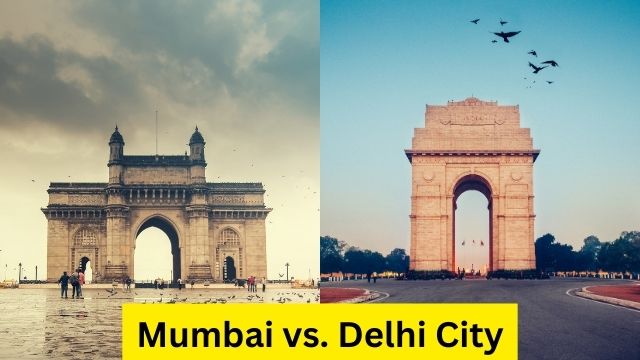The everlasting Mumbai vs. Delhi argument, seeking to decide the best city for habitation, remains a matter of intense conversation, frequently spawning friendly rivalries. These huge metropolitan cities, Mumbai and Delhi, each hold their particular attractiveness, lifestyle, and avenues of opportunity. Making a decision between the two may be a tough effort, considering the enormous number of experiences they present. In this post, we will analyze a number of characteristics to help your decision-making process, allowing you to identify whether Mumbai or Delhi better corresponds with your lifestyle and personal preferences.
Mumbai City vs. Delhi City

Cost of Living
Mumbai and Delhi have vastly different cost of livings, making financial analysis necessary. Mumbai’s high real estate costs make it difficult for budget-conscious people. This city has one of India’s highest housing and everyday expenditures. Delhi’s lifestyle is more cheaper. Many budget-conscious people choose the capital city since its housing choices span a broad range of prices. Thus, Delhi is generally more affordable for potential inhabitants.
Climate
Beyond finances, climate is another important factor in comparing these cities. Delhi has scorching summers and freezing winters. Residents may like winter, but summer’s heat may be oppressive. Mumbai has a mild coastal environment due to its closeness to the Arabian Sea. This closeness alleviates Delhi’s harsh temperatures. If one prefers warmer weather, Mumbai’s climate wins.
Employment Opportunities
Career seekers have several options in Mumbai and Delhi, two booming Indian cities with a variety of fields. Understanding each city’s offers is essential for choosing a career selection.
Mumbai, India’s financial hub, has skyscrapers and a busy commercial area. Many global firms and financial organizations have headquarters there, attracting people pursuing finance, banking, and related industries. Mumbai is home to Bollywood, the Indian film industry, which boosts the city’s economy. This has created a vibrant entertainment employment market for performing, producing, and creative positions. Mumbai’s broad and vibrant commercial environment includes technology, healthcare, and hospitality, attracting job seekers from many industries.
Delhi, India’s capital, houses government offices, embassies, and foreign organizations. Political significance has created a job market for government, corporate, and startup employment. Delhi’s role as India’s political hub benefits government and international organization job seekers. The city provides a unique platform for public policy, diplomacy, and global affairs influencers. Beyond government jobs, Delhi has a booming commercial sector in IT, telecommunications, retail, and hospitality.
Education
Delhi is known for its education. Delhi, Jawaharlal Nehru, and IIT Delhi are there. Due to these institutions’ diverse offers, Delhi draws students seeking high-quality education in many sectors.
However, Mumbai boasts prestigious institutions and colleges. The University of Mumbai, a longstanding institution, provides several undergraduate and postgraduate programmes. The Mumbai-based Tata Institute of Social Sciences offers humanities and social sciences programs.
Mumbai and Delhi provide outstanding education, thus selecting between the two cities often depends on which institutions and courses fit your requirements. Education fees, institution culture, and student lives may influence the decision.
Cultural and Lifestyle Diversity
Delhi and Mumbai, two of India’s most famous cities, represent different cultural and lifestyle experiences. Understanding different cultural landscapes is crucial to choose a place that suits your needs.
The cultural and historical legacy of Delhi, India’s capital, is vast. Monuments, museums, and historical sites invite you to explore India’s rich history. The city has architectural wonders including the Red Fort, Qutub Minar, and Humayun’s Tomb. Delhi’s food, which includes butter chicken, kebabs, and biryani, enriches its culture. The city’s celebrations, from Diwali to Holi, are huge and enthusiastic, capturing Indian customs.
Mumbai, the “melting pot” of India, is cosmopolitan and cultural. Its cultural richness reflects the city’s many communities. Mumbai’s diverse culinary culture showcases this variety, with traditional Maharashtrian and cosmopolitan specialties. The city celebrates Ganesh Chaturthi and Eid with equal zeal, transcending religion and culture. Mumbai’s fast-paced culture reflects the city’s vitality and provides Bollywood cinema, theater, and nightlife.
Which city has more cultural and lifestyle variety depends on your preferences. Delhi’s history invites you to discover India’s past, while Mumbai’s global vitality offers a multicultural, stimulating experience.
Transportation
Both cities have adequate transit alternatives. Delhi has a well-developed metro, bus, and road network. Mumbai’s local trains, buses, and taxis are dependable too. However, commuters who prefer efficient public transit favor Delhi’s metro network due to its extensive coverage and ease.
Safety
Safety is crucial while picking a location to live in. Delhi’s women’s safety issues have sparked countrywide discussions and requests for better protection. Due to its lower crime rate, Mumbai is considered safer. Many residents and tourists prefer Mumbai’s safe reputation, even if neighborhoods vary.
Conclusion
In conclusion, choosing between Mumbai and Delhi depends on personal interests and priorities. Delhi has a cheaper lifestyle, significant history, and a large metro system. Mumbai is appealing due to its mild temperature, cosmopolitan culture, and safety. Delhi’s historical beauty and Mumbai’s cosmopolitan vitality each have their own appeal. Your pick should match your job ambitions, lifestyle, and city climate and cost of living comfort. Finding the city that feels right for you—a location to call home amid India’s hectic metropolitan landscape—is the key.
Santosh Kumar, the author behind IndiasStuffs.com, is passionate about sharing valuable insights on a variety of topics, including lifestyle, technology, and Indian culture.
Page Contents

